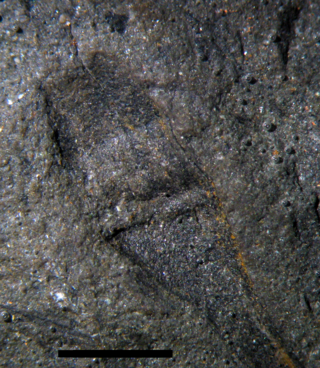The timeline of the evolutionary history of life represents the current scientific theory outlining the major events during the development of life on planet Earth. Dates in this article are consensus estimates based on scientific evidence, mainly fossils.

The evolution of plants has resulted in a wide range of complexity, from the earliest algal mats, through multicellular marine and freshwater green algae, terrestrial bryophytes, lycopods and ferns, to the complex gymnosperms and angiosperms of today. While many of the earliest groups continue to thrive, as exemplified by red and green algae in marine environments, more recently derived groups have displaced previously ecologically dominant ones; for example, the ascendance of flowering plants over gymnosperms in terrestrial environments.

Polysporangiophytes, also called polysporangiates or formally Polysporangiophyta, are plants in which the spore-bearing generation (sporophyte) has branching stems (axes) that bear sporangia. The name literally means 'many sporangia plant'. The clade includes all land plants (embryophytes) except for the bryophytes whose sporophytes are normally unbranched, even if a few exceptional cases occur. While the definition is independent of the presence of vascular tissue, all living polysporangiophytes also have vascular tissue, i.e., are vascular plants or tracheophytes. Extinct polysporangiophytes are known that have no vascular tissue and so are not tracheophytes.
Grisellatheca was a genus of land plant with branching axes. It is known from charcoalified Early Devonian deposits, its type locality being the Brown Clee Hill lagerstatten. Its Terahedraletes spores form permanent tetrads.
Fusitheca was a genus of land plant with branching axes. It is known from charcoalified Early Devonian deposits, its type locality being the Brown Clee Hill lagerstätten. Its spores form smooth-walled, unfused, naked dyads. Its axis comprises length-parallel filaments, and their dichotomies are T-shaped, with the branches bending to continue upwards.
Culullitheca was a genus of land plant with branching axes. It is known from charcoalified Early Devonian deposits, its type locality being the Brown Clee Hill lagerstätten. Its spores formed permanent dyads.
Dutoitia is a genus of Devonian rhyniophyte, named after the renowned South African geologist Alex du Toit. It is one of the earliest plants from Gondwana to colonize land. Its fossils were preserved in fine mudstones of the 400-million-year-old Bokkeveld and Witteberg Groups of South Africa. This erect, gracile plant is less than 10 cm high and very simple in structure. Its diminutive stems, which are devoid of leaflike appendages, branch in two and end in club- or cup-shaped sporangia, occasionally containing its reproductive spores. Stomata are present in the cuticle of their stems for gas exchange, and primitive cells inside the stems transported water from the roots to the aerial parts of the plant. Three species are recognized, D. pulchra Hoeg 1930, D. alfreda Plumstead 1967 and D. maraisia Plumstead 1967.
Eogaspesiea was a genus of Early Devonian rhyniophyte with a tangled mess of branching axes that reached 10 cm in length. These probably emanated from a rhizome. Its (probably) alete spores had thin walls.
Bathurstia was a genus of scrambling Silu-Devonian land plant with isotomously branching axes that grew to heights of 30 cm. It is aligned with the Zosterophylls, and produced Calamospora-type spores.
Thrinkophyton was a genus of Early Devonian land plant with branching axes. Known fossils are of Lochkovian to Pragian age.
Gosslingia was a genus of Early Devonian land plant with branching axes. Fossils have been from the Lochkovian to the Pragian, 419 to 408 million years ago.
Serrulacaulis was a genus of early land plant with branching axes. Known fossils are of Late Devonian age.
Tarella was a genus of Early Devonian land plant with branching axes. Fossils came from Pragian age rocks.
Oricilla was a genus of Early Devonian land plant with branching axes. Fossils have been found from the Pragian to the Emsian.
Konioria was a genus of early land plant with branching axes. Known fossils are of Early Devonian age.
Deheubarthia was a genus of Early Devonian land plant with branching axes.
Anisophyton was a genus of Early Devonian land plant with branching axes. Known fossils are of Emsian age.

Sporogonites was a genus of Lower Devonian land plant with branching axes. It is known from Europe, Australia and Newfoundland. It resembles a moss in that many straight axes, which grew to about five centimetres in height and possess terminal sporangia, grow from a planar basal surface. Its spores were trilete and around 30 µm across.
Odonax was a genus of Early Devonian zosterophyll with branching axes. It bore kidney-shaped sporangia and spiny branches.
Tortotubus is an early terrestrial fungus. Its growth trajectory can be ascertained from its fossils, which occur across the globe from the Ordovician to the Devonian. These fossils document foraging activities of slender, cell-wide exploratory hyphae; when these hit a source of food, they produced secondary branches that grew back down the original filament, covered themselves with an envelope, and served as pipes to shuttle nutrients to other parts of the organism. Today, mycelium with this growth pattern is observed in the mushroom-forming fungi.


